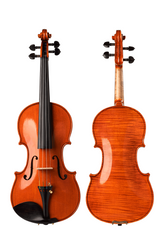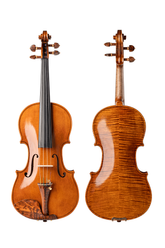Basic knowledge of violin wood 2: wood processing
Only treated and well-preserved wood can be used to make violins, so there are strict requirements for the processing of wood.
Felling:
Generally, the wood for making violins is felled in winter, when the climate is cold and dry and the trees are dormant. The wood used to make the violin grows in the mountains at an altitude of 2000-3000 meters. On the one hand, the snow in winter is conducive to the transportation of wood, on the other hand, the cold and dry environment, so the wood is still living, not easy to mold and decay, and will not germinate and grow branches. When felling the bark will be removed for the first time, because the bark will affect the drying of the wood during transportation and storage, and it is prone to insects and mildew. (If the wood is moldy or deteriorated, it will not meet the requirements for making a violin)
Choose:
Different parts of the violin have different requirements for wood but generally follow the basic principles. Choose a tree with a long age and a thick diameter at breast height, and the age of the tree can be estimated based on the number of rings. Since the wood grows from the inside out, the wood used for making the violin is the most suitable one that is in the middle of the whole tree and is in the middle of the cross-section. The trunk should be tall and straight, healthy and free of signs of moth and mildew, and free from scarring and resin pockets, which can lead to failure of the violin making. The annual rings should not be too curved and annular, the spacing should not be locally widened or narrowed, and the ratio of spring wood and autumn wood should not be too different. Moreover, the color and luster on the cross-section should be consistent, and the annual rings of different ages should not be darker or lighter, which will affect the strength uniformity and acoustic performance of the wood. Trees growing on the southern slopes of the mountain will be of better quality (northern hemisphere).
Sawing:
There are three main ways of sawing wood: flat sawn, quarter sawn, and ture quartersawn. Different ways of sawing can have a very big impact on the wood, and sawing ways have a significant impact on the acoustic performance and appearance of the violin. For details, please read "Do you know how the wood used to make the violin is sawed?".
Dry:
When buying a violin, sometimes businesses will mention the drying time of the wood in the product details, such as 5 years and 10 years. After the log has been dried for several years, it is sawn and continues to dry. According to the requirements of making the violin, it is sawed into the required size, but generally, there will be more allowance than the actual amount, because the wood will shrink during the drying process, and the longitudinal shrinkage is smaller than the horizontal shrinkage, on the cross-section of the wood, prone to cracks and fine cracks due to unbalanced shrinkage. Therefore, after the wood is cut to the desired size, lacquer or wax is applied to the cross-section to slow the evaporation of water there. In fact, in the drying process of wood, not only the evaporation of water but also the volatilization and shrinkage of other substances. In the process of natural drying, drying at an appropriate temperature will make the wood structure uniform, the color changes little, and the wood fibers will not be fragile. If an artificial high temperature is used for drying, the effect of natural drying will not be achieved, which makes it difficult to store the produced violin for hundreds of years.
Follow Fiddlover to learn more about the violin.





